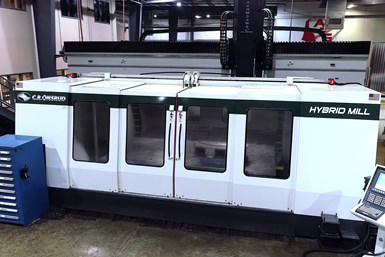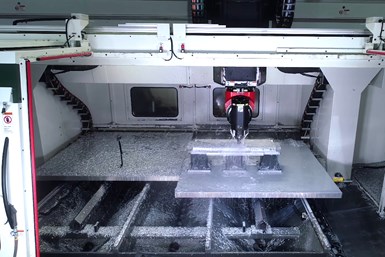Onsrud's Hybrid Mills Streamline Large Metal Manufacturing
C.R. Onsrud’s five-axis Hybrid Mill machining centers helped Aerospace Fabrications streamline its products’ machine times by as much as 40%.

Sometimes large workpieces don’t need machined on a large-format, five-axis machining center that is built to hold incredible tolerances in hard-to-cut materials such as titanium. Instead, it might be the case that a shop just needs an efficient, lower-cost option for machining large aluminum parts. Just ask Adam Grizzle, CEO and owner of Aerospace Fabrications of Georgia Inc., who has put his C.R. Onsrud Hybrid Mill through its paces after a year of ownership and daily operation.
“We absolutely fell in love with the Hybrid Mill as soon as we saw it,” he says. “One of the more immediate production process improvements that we noticed as soon as we started moving existing product lines over to the C.R. Onsrud hybrid was the ability to take advantage of the range of its articulated head — the angularity that we were able to reach within our part numbers greatly improved our ability to machine a complete product in a single phase or in a single setup.”
The spindle head C-axis capability, which can be used to articulate auxiliary milling heads or apply multi-spindle options, is just one of a variety of options that are available for C.R. Onsrud machining centers. The Hybrid Mill’s twin 72 × 72-inch tables enable manufacturers to either process two parts in a single machining cycle on independent tables or synchronize the tables to machine larger parts. The optional Dual Process system, which adds a second Z-ram and head to the gantry, even allows manufacturers to run two different machining programs simultaneously.

The Hybrid Mill features a standard 15-horsepower, 24,000-rpm spindle, and optional spindles ranging to 75 horsepower, with high-torque versions available. X-, Y- and Z-axis travel ranges measure 122 × 196 × 41 inches or 146 × 244 × 41 inches, depending on the model. The machining center can machine at up to 3,000 ipm, with rapid traverse speeds of 4,200 ipm. It comes standard with a FANUC 31iB5 control.
Grizzle appreciates the efficiency and flexibility these features have brought to his shop. For example, he says the common task of placing pilot holes in standing legs had always been a manual process that was much more time-consuming and much less accurate before purchasing the Hybrid Mill. After his team grew accustomed to the machine, he says they converted many of the shop’s part numbers over to the to the Hybrid Mill simply to be able to save time and improve accuracy for their customers.
“This being our very first Onsrud purchase, and certainly our very first purchase of an articulating-head machine, we’ve actually been able to reduce many of our products’ machine times by as much as 40%, using this machine over equipment that, quite frankly, I thought we were already getting a very efficient manufacturing rate on,” Grizzle says.

The Hybrid Mill’s work envelope also impressed Grizzle. “If, number one, you have some low to medium manufacturing rate products,” he says, “and you’re machining materials such as aluminum or some other softer alloys, that is certainly something that fits quite well. You’re able to combine that same articulating head range with such a large work envelope such as you would see in the aerospace industry. I can’t imagine a better fit.”
Indeed, beyond the dimensions of the work envelope, the Hybrid Mill has several features that allow it to accommodate large workpieces. An optional integrated vacuum workholding system for fixtureless workholding supports large plate work. High acceleration and deceleration rates help with traversal of large distances from one workpiece feature to another, or to the toolchanger and back. C.R. Onsrud’s standard machines are capable of holding within 0.005-inch tolerance or better across the full axis travel range. Optional linear scales and volumetric laser compensation shrinks these tolerances below 0.001 inch, which C.R. Onsrud says is difficult outside of a controlled thermal environment. Across shorter machining travel distances, the company says its standard machining centers routinely hold tolerances of 0.001 inch or less.
C.R. Onsrud provides many customization options for its Hybrid Mill in terms of in size, accessories and features — flood coolant, minimum quantity lubrication (MQL) delivery systems and through-the-tool coolant being chief among them.
Grizzle says when he first turned on his Hybrid Mill, it held its own. In fact, he says that within a couple of days, he had employees really jockeying for the position of being the first full-time operator for the piece of equipment. Laughing, he says that the only way all the people in his shop who want to operate the Hybrid Mill could have a chance to do so would be “for us to just go ahead and try to purchase another one.”
Related Content
Best Practices: Machining Difficult Materials
Cutting hardened steel, titanium and other difficult materials requires picking the right tools, eliminating spindle runout and relying on best practices to achieve tight part tolerances.
Read MoreHow to Successfully Adopt Five-Axis Machining
While there are many changes to adopt when moving to five-axis, they all compliment the overall goal of better parts through less operations.
Read MoreCNC Machine Shop Honored for Automation, Machine Monitoring
From cobots to machine monitoring, this Top Shop honoree shows that machining technology is about more than the machine tool.
Read MoreBuilding a 5-Axis Cell
5-axis machining has taken over the metalworking industry, but what goes into a high-functioning 5-axis machining cell?
Read MoreRead Next
A More Affordable Approach to 5-Axis Large Part Machining
Shops that machine large aluminum parts don’t have to pay millions of dollars for a machining center just to get the work envelope they need. There is a more affordable alternative, and it’s manufactured in the USA.
Read MoreComposites Specialist Makes CNC Chops Count
Machining capability drives evolution from race car builder to aerospace and defense contractor.
Read MoreTaking an Automated Aerospace Approach
A flexible manufacturing system helps an Indiana job shop run a high mix of aerospace work for long stretches of time and function more like a contract shop.
Read More.jpg;maxWidth=970;quality=90)







.jpg;maxWidth=300;quality=90)





.png;maxWidth=300;quality=90)












